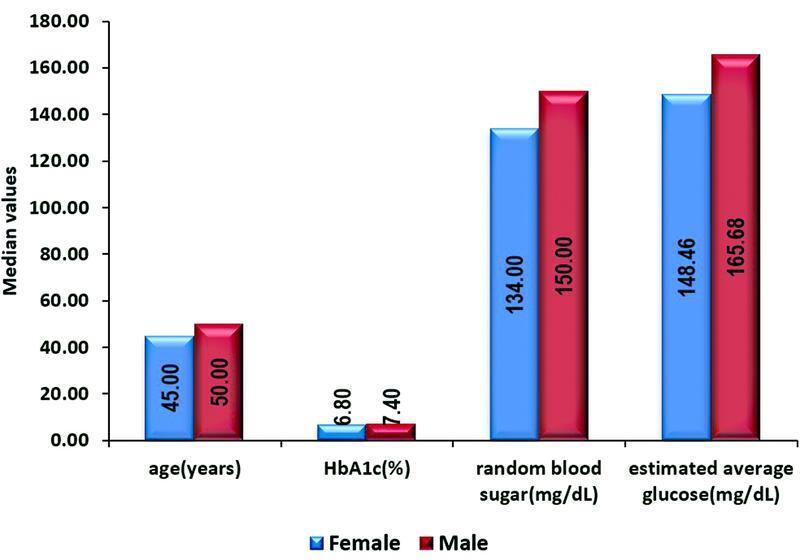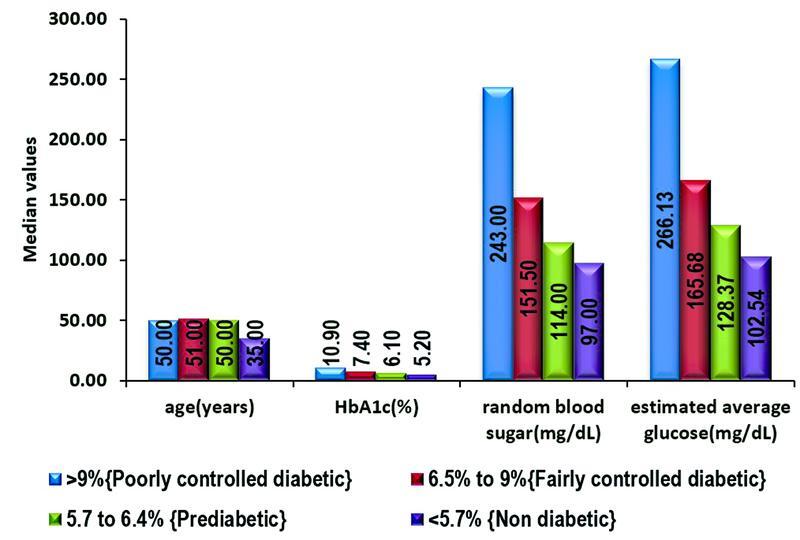Correlation between Estimated Average Glucose Levels Calculated from HbA1c Values and Random Blood Glucose Levels in a Cohort of Subjects.
IF 1
Q3 MEDICINE, GENERAL & INTERNAL
引用次数: 0
Abstract
Abstract Objective Hemoglobin A1c (HbA1c) level remains the gold standard test for the assessment of glycemic control, and it reflects the mean glucose values in the previous 3-month period. HbA1c is expressed as a percentage, whereas the monitoring and treatment of diabetes are based on blood glucose levels expressed as mg/dL. It is appropriate to make it easy for the patient to understand both random blood sugar (RBS) and estimated average glucose (eAG) expressed with the same units. This will enhance the usefulness of eAG. This article determines the statistical correlation between eAG derived from HBA1C with RBS values both in diabetic and prediabetic subjects. Methods The RBS and HbA1c levels of 178 males and 283 females (12–90 years) were obtained and the eAG levels were calculated using Nathan's regression equation. The samples were divided into four groups based on HbA1c levels—group 1: HbA1c greater than 9%, group 2: HbA1c 6.5 to 9%, group 3: HbA1c 5.7 to 6.4%; and group 4: HbA1c less than 5.7%. Results There was a statistically significant positive correlation between RBS and eAG values for the study group 1 and 2. Also, the median values of RBS and eAG showed a significant difference ( p < 0.001). Conclusion As the association between the RBS and eAG levels is strong in a fairly and poorly controlled diabetic population, reporting the eAG level together with the HbA1c level at no additional cost may assist in effective blood glucose control in clinical care. However, eAG and RBS values cannot be used interchangeably.



在一组受试者中,由HbA1c值计算的估计平均血糖水平与随机血糖水平的相关性
目的血红蛋白糖化血红蛋白(HbA1c)水平仍然是评估血糖控制的金标准指标,它反映了前3个月的平均血糖值。HbA1c以百分比表示,而糖尿病的监测和治疗是基于以mg/dL表示的血糖水平。随机血糖(RBS)和估计平均血糖(eAG)用相同的单位表达时,应便于患者理解。这将增强eAG的有用性。本文确定了糖尿病和糖尿病前期受试者HBA1C所得eAG与RBS值之间的统计学相关性。方法收集男性178例、女性283例(12 ~ 90岁)的RBS和HbA1c水平,采用Nathan回归方程计算eAG水平。根据HbA1c水平将样本分为4组:1组:HbA1c大于9%,2组:HbA1c 6.5 ~ 9%, 3组:HbA1c 5.7 ~ 6.4%;第4组:HbA1c < 5.7%。结果研究组1和研究组2的RBS与eAG值有统计学意义的正相关。结论:在控制良好和控制不良的糖尿病人群中,RBS和eAG水平之间的相关性很强,在不增加费用的情况下报告eAG水平和HbA1c水平可能有助于临床护理中有效的血糖控制。但是,eAG和RBS值不能互换使用。
本文章由计算机程序翻译,如有差异,请以英文原文为准。
求助全文
约1分钟内获得全文
求助全文

 求助内容:
求助内容: 应助结果提醒方式:
应助结果提醒方式:


